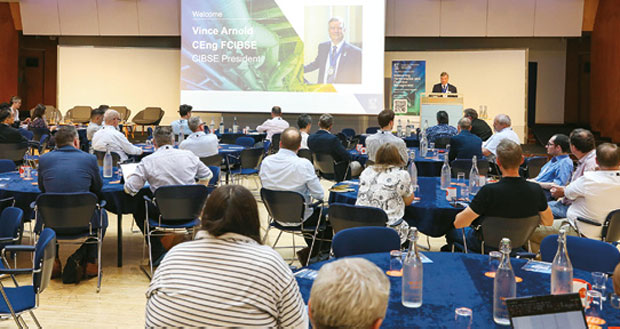 CIBSE’s Measuring Performance and Facilities Management 2025 Conference brought together leading voices from across the built environment to explore the evolving landscape of building performance. Madeleine Ford reports
CIBSE’s Measuring Performance and Facilities Management 2025 Conference brought together leading voices from across the built environment to explore the evolving landscape of building performance. Madeleine Ford reports
CIBSE’s Measuring Performance and Facilities Management Conference, held on June 19, centred around driving data-led decisions for a sustainable, efficient future. It set out to foster participation, challenge assumptions and share experiences. Leading voices from across the built environment brought a range of experiences and honest reflection on important themes such as building management systems, post-occupancy evaluation, data-driven decision making, and health and wellbeing metrics.
TECH & SUSTAINABILITY
The event highlighted the urgent need to move from theoretical targets to operational outcomes, specifically in the context of net zero ambitions. The agenda offered actionable insights into optimising building performance through smarter FM strategies in the panel discussions and real-world case studies presented throughout the day.
COLLABORATION AND ACCOUNTABILITY
The day started with a session on collaboration and accountability with a unanimous call for a culture shift in project delivery, which involves bringing FM and operations teams into the conversation from the very beginning. The discussion, chaired by CIBSE President Vince Arnold, highlighted how aligning objectives across disciplines, setting clear responsibilities, and prioritising operational knowledge can achieve greater value in facilities management. Arnold proclaimed that in the built environment, there is a growing recognition that performance must be “understood as something that evolves and must be designed, maintained, monitored, and improved at every opportunity”.
His message was that achieving true operational excellence goes far beyond a tick box exercise, it’s about ensuring buildings work as intended, that they are efficient, safe, resilient, and support the people who live and work in them. And to do this, a collaborative model must be taken.
HUMAN-CENTRIC SPACES
A key theme of the conference was the human dimension of performance. Multiple sessions focused on strategies for harmonising performance optimisation with occupant wellbeing, in particular, how buildings can be tuned not only for energy and cost-efficiency, but also for health and comfort.
Dr Philip Webb emphasised this in his discussion on the significant impact of poor environmental quality on health, noting that 83 per cent of non-communicable diseases and deaths in western populations are linked to air quality. Webb explained the long-term health consequences of having poorly built and designed buildings, particularly those that are frequented by vulnerable individuals such as schools. He called for better regulation and monitoring of building designs to ensure health and safety regulations are met. Webb’s talk closed with an emphasis on the need for a stronger focus on the economic and moral implications of building design.
CLOSING THE DESIGN TO OPERATION GAP
Several sessions throughout the day focused on the persistent disconnect between design intent and actual building operations. Panellists shared real-world experiences that had failed operationally due to over-engineered or inaccessible plant, lack of commissioning clarity or assumptions made without FM input. It was frequently noted among speakers that FM involvement in projects and greater collaboration across disciplines will help to ensure buildings perform as intended long after handover.
The key takeaways presented from different speakers’ experiences were the value of designing with maintainability and accountability in mind and ensuring that building systems are fully understood by those who are running them.
Alongside this, the concept of ‘soft landings’ was highlighted to ensure buildings are easily maintained and accessible, which means improving operational performance and minimising defects by involving all key stakeholders from the outset. It was argued that achieving this shift would reduce long-term costs, improve system reliability, and empower FM teams to manage more proactively.
STRATEGIC ROLE FOR FM
The conference reaffirmed that facilities management is no longer simply about upkeep and compliance, it is evolving into a strategic discipline; one that enables buildings to meet performance goals over time, respond to user needs, and support the transition to a low carbon future. CIBSE Vice President David Stevens stated that FM professionals should lead proactively, as they are central to this shift whether through better collaboration, smarter use of data, or human-centred design thinking.
CONCLUSION
CIBSE’s Measuring Performance and Facilities Management Conference provided a platform for the FM sector to rethink its role, not just as a service provider, but as a strategic partner in delivering better, healthier, and more sustainable buildings. Additionally, as the sector looks to tackle both climate challenges and growing performance expectations the day allowed for vital knowledge exchange, innovation and collaboration.
As stated by Dr Anastasia Mylona, Technical Director at CIBSE: “Sharing practical approaches and lessons learnt is central to improving outcomes and empowering the professionals who shape the buildings we live and work in.”





